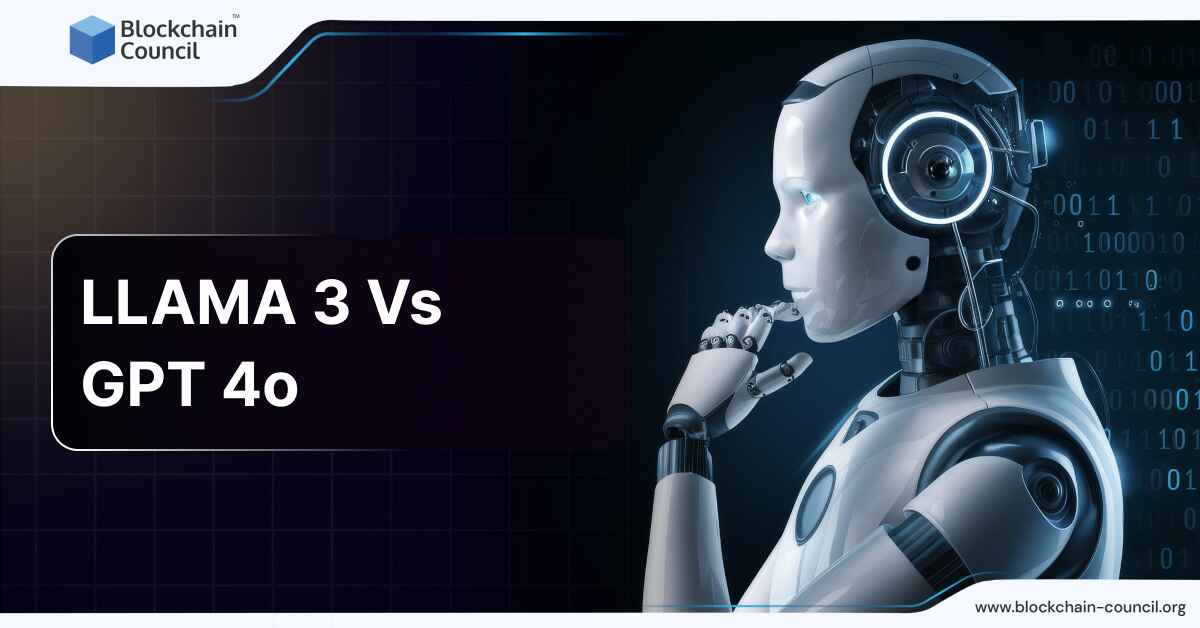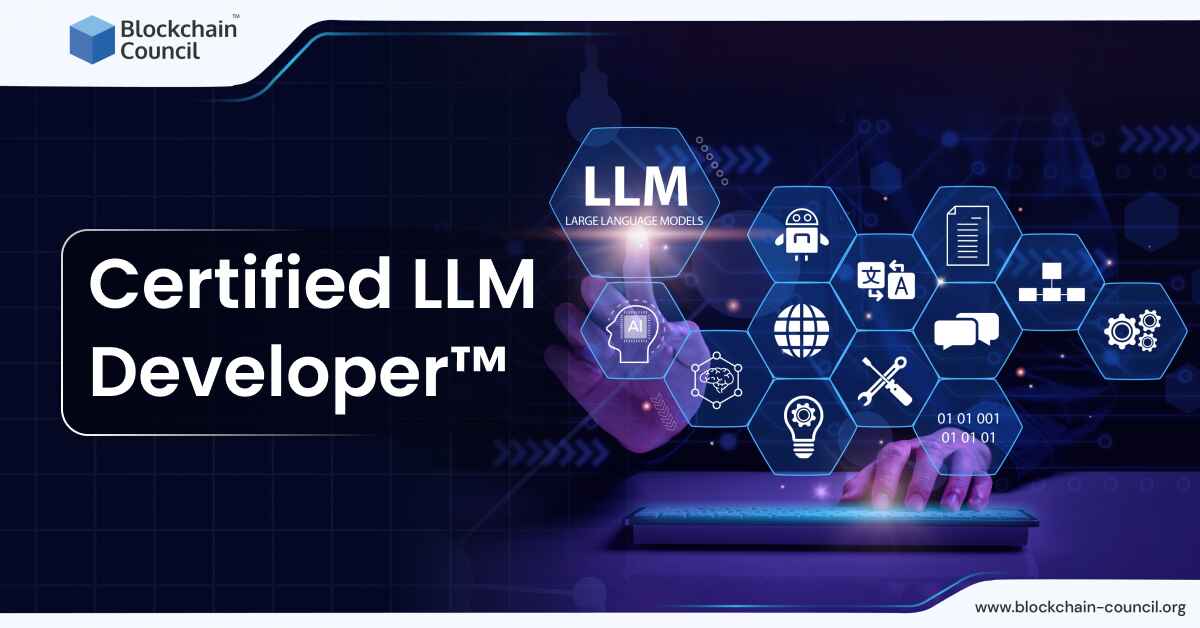
- Blockchain Council
- August 22, 2024
Llama 3 and GPT-4o (Omni) are two of the latest language models making waves in the tech world. Both are designed to help with different tasks, from coding to natural language processing. But who wins the race between LLAMA 3 Vs GPT 4o? Let’s find out!
LLAMA 3: Architecture and Capabilities
Llama 3 is an advanced language model developed by Meta, with two key versions featuring 8 billion (8B) and 70 billion (70B) parameters. It builds on its predecessor, Llama 2, with several enhancements that make it more effective and efficient.
Architecture
Llama 3 uses a decoder-only transformer architecture, a common choice for language models. It improves on previous versions with a larger tokenizer vocabulary of 128,000 tokens, making the model understand and process language more effectively. The model also employs Grouped Query Attention (GQA) to enhance inference efficiency. Training sequences are capped at 8,192 tokens, with mechanisms to prevent cross-document self-attention.
Core Features
Training Data and Process
The training dataset for Llama 3 is significantly larger, comprising over 15 trillion tokens from publicly available sources. This dataset includes diverse content, ensuring better performance across various use cases, including coding and multilingual tasks. The model’s training data has four times more code and includes 5% non-English content covering over 30 languages. Extensive data filtering and quality checks were performed to ensure high-quality training data.
Capabilities
Llama 3 demonstrates improved capabilities in reasoning, coding, and instruction-following. Its fine-tuning process includes supervised fine-tuning, rejection sampling, proximal policy optimization, and direct preference optimization. These methods refine the model’s ability to follow instructions accurately and generate useful outputs.
Performance
Llama 3 models show state-of-the-art performance in benchmarks and real-world tasks. The 70B parameter model, in particular, excels in various human evaluations, outperforming other models like Claude Sonnet, Mistral Medium, and GPT-3.5. The model’s design ensures it remains efficient during inference, despite its increased size.
GPT-4o: Architecture and Capabilities
GPT-4o is an advanced AI model developed by OpenAI. It processes text, images, and audio input, providing text, audio, and image outputs. This versatility enables more natural interactions between humans and computers.
Architecture
GPT-4o features an end-to-end model design, which means it processes all types of inputs and outputs using a single neural network. This unified approach improves the model’s efficiency and understanding. Unlike previous models, which used separate pipelines for different tasks, GPT-4o handles text, vision, and audio in a cohesive manner. This allows for better context comprehension and response generation.
The model’s neural network consists of numerous interconnected layers that analyze and generate data. These layers work together, improving the model’s ability to understand complex patterns in language, images, and sounds. This integration helps GPT-4o provide more accurate and contextually appropriate responses.
Core Features
- Unified Model: GPT-4o processes all types of inputs—text, images, and audio—within a single model. This design allows it to understand and generate outputs more effectively.
- Speed and Efficiency: With response times as low as 232 milliseconds for audio, GPT-4o interacts almost as quickly as humans in a conversation. It also performs faster and more cost-effectively compared to previous models, making it accessible to a wider audience.
- Multilingual and Multimodal Capabilities: GPT-4o excels in understanding and generating content in multiple languages. It shows significant improvements in handling non-English texts and comprehends visual and auditory data better than its predecessors.
- Enhanced Interactions: Unlike older models, GPT-4o can handle complex audio inputs. It detects tone, multiple speakers, and background noises, producing more natural and engaging responses.
LLAMA 3 Vs GPT-4o
Developers and Access
LLAMA 3, developed by Meta AI, and GPT-4o, by OpenAI, are both advanced language models with unique strengths. Meta AI provides access to LLAMA 3 through its own platform and partners, whereas GPT-4o is accessible via OpenAI’s platform and API subscriptions.
Performance and Accuracy
LLAMA 3 shows notable performance in specific areas. It excels in coding tasks, often outperforming GPT-4 in benchmarks like HumanEval, where LLAMA 3 scored 81.7 compared to GPT-4’s 67. Additionally, LLAMA 3 demonstrates high accuracy in multilingual tasks and logical reasoning.
GPT-4o, on the other hand, is known for its overall robustness and versatility. It scores higher in general language understanding and context comprehension. GPT-4o’s architecture allows it to handle large-scale language tasks efficiently, making it ideal for diverse applications from text generation to complex data analysis.
Speed and Efficiency
In terms of speed, GPT-4o is approximately 30% faster than its predecessor, GPT-4, which enhances its real-time responsiveness. LLAMA 3 is also optimized for speed and efficiency, offering quick processing times and reduced operating costs, making it suitable for business environments.
Applications and Use Cases
Both models serve a variety of applications:
- LLAMA 3: Particularly strong in coding, multilingual translation, and tasks requiring logical reasoning. It’s suitable for environments where Meta’s integration tools are used.
- GPT-4o: Excels in natural language tasks, customer support, data analysis, and multimodal applications (text and image). It’s favored for its comprehensive language understanding and versatility.
Customization and Integration
LLAMA 3 supports fine-tuning for specific use cases, allowing more flexibility for developers to adapt the model to their needs. GPT-4o offers extensive customization options through its API, which helps in tailoring the model for various applications.
Cost
The cost of using these models varies. GPT-4o is priced at $30 per million prompt tokens and $60 per million sampled tokens. The cost for LLAMA 3 has not been publicly disclosed but is available for free customization within certain limits.
Ethical Considerations
Both models face scrutiny regarding ethical use. LLAMA 3’s open-source nature allows for broader adaptation but also poses risks of misuse. GPT-4o is criticized for a lack of transparency in its training data, raising concerns about perpetuating biases and user privacy.
Performance Analysis of Llama 3 Vs GPT 4o
GPT-4 Omni:
- Multimodal Capabilities: Accepts text, audio, image, and video inputs, and outputs text, audio, and images. This makes it versatile for various applications, including real-time translation and customer service.
- Speed and Efficiency: Responds to audio inputs in around 320 milliseconds, twice as fast as previous models. It’s 50% cheaper and 2x faster than GPT-4 Turbo.
- Benchmark Performance: Excels in multiple benchmarks, setting high marks in text generation, reasoning, and coding. GPT-4 Omni scores top in HellaSWAG, MMLU, DROP, GPQA, and HumanEval benchmarks.
- Text and Image Integration: Outperforms in tasks requiring text-to-image generation and understanding, making it ideal for creative applications.
Llama 3:
- Strong in Textual Tasks: Specializes in text-based tasks and excels in coding, problem-solving, and creative writing. It performs well in benchmarks, particularly in contexts aligned with Meta’s ecosystem.
- Efficiency with Fewer Parameters: Despite having fewer parameters, Llama 3 matches or exceeds GPT-4’s performance in several tasks due to efficient training techniques.
- Future Multimodal Potential: Currently supports textual inputs and outputs, but Meta plans to develop multimodal capabilities similar to GPT-4 Omni.
- Open-Source Flexibility: Llama 3’s open-source nature allows for extensive customization, making it suitable for specialized applications. However, this also poses some risks in terms of misuse.
Key Differences
- Multimodal vs. Textual Focus: GPT-4 Omni’s strength lies in handling various input and output types, making it versatile across different scenarios. Llama 3 currently focuses on text but plans to expand to multimodal capabilities.
- Speed and Cost: GPT-4 Omni is optimized for faster responses and lower costs, making it more accessible for high-demand applications.
- Customization and Flexibility: Llama 3’s open-source model allows for greater customization, which can be both a benefit and a risk depending on usage.
- LLAMA 3 performs well in specific benchmarks like Python coding and grade school math tasks, demonstrating a 15% higher performance in coding compared to GPT-4. However, it struggles with more complex middle school math riddles and higher-level reasoning tasks.
- GPT-4 Omni generally scores higher in most benchmarks, especially in multi-choice questions, reasoning tasks, and complex problem-solving. Its extensive training data and advanced architecture give it a notable edge in accuracy and coherence.
How Can We Access LLAMA 3?
To access Llama 3, follow these steps:
1. Using Hugging Chat
- Visit the Hugging Chat Website: Go to the Hugging Chat homepage.
- Sign Up or Log In: Use your email ID to create an account or log in as a guest.
- Select the Model: Click on the settings icon and choose the Llama 3 model you want to use.
- Start Interacting: You can now start using Llama 3 by typing your queries. Note that as a guest, you are limited to two questions.
2. Running Locally with Ollama
- Install Ollama: Use the command pip install ollama to install the necessary package.
- Start the Server: Run the command ollama serve in your terminal.
Use the Model in Python:
import ollama
response = ollama.chat(
model=”llama3″,
messages=[
{
“role”: “user”,
“content”: “Tell me an interesting fact about elephants”,
},
],
)
print(response[“message”][“content”])
- VSCode Integration: Install the CodeGPT extension in VSCode, set it up with Ollama, and start using Llama 3 for code suggestions and other tasks.
3. Using Amazon Bedrock
- Access the Console: Go to the Amazon Bedrock console.
- Request Model Access: Select the Llama 3.1 models (8B, 70B, or 405B Instruct) and request access.
- Test the Model: Use the Text or Chat option in the Playgrounds section. You can also use the provided API examples to interact with the models programmatically.
4. Using Replicate
Sign up on Replicate, get your API key, and use their API to access LLAMA 3. Here’s a simple example in Python:
import replicate
input = {
“prompt”: “Write a poem about AI”,
“prompt_template”: “<|begin_of_text|><|start_header_id|>system<|end_header_id|>\n\nYou are a helpful assistant<|eot_id|><|start_header_id|>user<|end_header_id|>\n\n{prompt}<|eot_id|><|start_header_id|>assistant<|end_header_id|>\n\n”,
}
for event in replicate.stream(“meta/meta-llama-3-70b-instruct”, input=input):
print(event, end=””)
How Can We Access GPT 4o?
To access GPT-4o (Omni), follow these steps:
- Create an OpenAI Account: Sign up at OpenAI’s platform if you don’t have an account.
- Choose a Plan:
- Free Tier: Provides limited access to GPT-4o with a message cap based on demand and usage.
- Plus, Team, or Enterprise Plans: Offers more extensive access. Plus users can send up to 80 messages every three hours. These plans also include access to advanced tools and higher usage limits.
- Access Through ChatGPT:
- Visit ChatGPT and log in.
- Free users can access GPT-4o directly but may be switched to GPT-4o mini when demand is high.
- Plus and Team users can select GPT-4o from the model drop-down menu at the top of the page.
- Use the API:
- Developers can access GPT-4o via the OpenAI API. Ensure your account has a minimum payment of $5.
- Use the API documentation available on the OpenAI Platform to integrate GPT-4o into your applications.
- Install Desktop App (Optional):
- OpenAI offers a desktop app for macOS, with a Windows version planned. This app integrates ChatGPT functionalities directly into your computer.
Conclusion
Choosing between LLAMA 3 and GPT-4o depends on your specific needs. LLAMA 3 excels in coding and text-based tasks, making it a solid choice for developers. GPT-4o offers a versatile solution with its ability to process text, images, and audio, making it ideal for more complex, multimodal applications.
Both models are impressive in their own right, showing just how far AI technology has come. Understanding the differences between LLAMA Vs GPT-4o can help you decide which one fits your project best. To make the most of these models, you must know how to use prompts correctly.
You can enroll into globally recognized certifications like the Certified Prompt Engineer™ by the Blockchain Council that will not only help you make the most of these models, but also enhance your credibility and career potential in the AI industry as a certified professional.
FAQ’s
What are the main differences between LLAMA 3 and GPT-4o?
- LLAMA 3 focuses on coding and multilingual tasks; GPT-4o excels in natural language and multimodal tasks.
- LLAMA 3 uses a decoder-only transformer; GPT-4o uses an end-to-end design.
- LLAMA 3 allows extensive customization; GPT-4o offers customization through API.
- GPT-4o is generally faster and more efficient in real-time tasks.
How can I access LLAMA 3?
- Hugging Chat: Sign up or log in, select LLAMA 3, and start interacting.
- Running Locally: Install Ollama, start the server, and use the model in Python.
- Amazon Bedrock: Request access via the console and use in the Playgrounds section or via API.
- Replicate: Sign up, get an API key, and access LLAMA 3 using Replicate’s API.
What are the key features of GPT-4o?
- Processes text, images, and audio within a single model.
- Responds quickly, with times as low as 232 milliseconds for audio.
- Handles multiple languages and visual/auditory data well.
- Detects tone, multiple speakers, and background noises for natural responses.
What are the costs associated with using LLAMA 3 and GPT-4o?
- LLAMA 3: Free customization within certain limits; specific costs not disclosed.
- GPT-4o: $30 per million prompt tokens and $60 per million sampled tokens. Free and paid plans available.





































































 Guides
Guides News
News Blockchain
Blockchain Cryptocurrency
& Digital Assets
Cryptocurrency
& Digital Assets Web3
Web3 Metaverse & NFTs
Metaverse & NFTs
